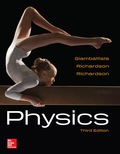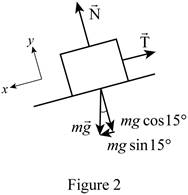
The tension on cord using the work –energy theorem, Newton’s law and give your preferred way of solving the system with reason.
Answer to Problem 93P
The tension is
Explanation of Solution
Mass of block is
Refer the figure 1 given below.

Write the equation for work- energy theorem for the motion of block from top to bottom of the incline.
Here, the work done by the conservative force is
Rewrite the above equation by considering that the velocity at both top and bottom of incline is zero. This makes the change in kinetic energy also zero.
Write the relation between
Here, the change in in potential energy at the top and bottom of incline is
Write the relation between
Here, the tension on the cord is
Rewrite equation (I) by substituting equation (II) and (III).
Write the equation for
Here, the mass of block is
Write the equation for
Here, the length of incline is
Rewrite the equation for
Rewrite equation (IV) by substituting the above relation for
Refer figure 2 shown below to find

To apply the Newton’s law, motion of block is divided into two parts. First part is the motion of block from the top of incline to until a moment just before the cord is grasped. Note that at block starts from rest at the top of incline.
Second part is the motion is from the point of cord is grasped to till the block comes to rest. Note the first part of motion is a speed-up process and the second part is a speed down process.
Write the equation for net force in x-direction.
Here, the normal reaction force on the block is
Write the equation for net force in x-direction.
Here, the acceleration of block is
Rewrite the above relation by eliminating
Write the Newton’s third equation of motion for the block from top just before the cord is grasped.
Here, the velocity of block just before the cord is grasped is
Write the equation for x-component of force when the cord is grasped.
Here, the x-component of acceleration is
Rewrite the above relation in terms of
Write the Newton’s third equation of motion for the second part of motion. Note that the final velocity of first part of motion is the initial velocity of second part of the motion.
Rewrite the above equation by substituting the equations (VI) and (VII).
Rewrite the above relation in terms of
Write the relation between
Rewrite equation (IX) by substituting the above relation for
The above equation is same as that of equation (V).Thus; both methods will give the same relation for
Conclusion:
Substitute
The method using work –energy theorem is preferred. This is because of the reasons like less calculations, no need of fee body diagram. No need of concern about direction of vector quantities, and need to split the motion into two parts.
Therefore, the tension is
Want to see more full solutions like this?
Chapter 6 Solutions
Physics
- I need help with how to solve this answer, thank you !arrow_forwardI need help with how to solve this answer, thank you !arrow_forwardIs work function of a metals surface related to surface energy and surface tension? What is the need to the work function component in the math of tension of metal surfaces that cannot be provided by existing equations of surface energy and surface tension? What are the key differences in each parameter and variables that allow for a differentiation of each function? What has a more significant meaning work function, surface tension or surface energy? Are there real differences and meaning? Please clarify and if possible provide examples . Does surface tension dependant on thickness of a metal or type of metal surface all having the same thickness? Clearly temperature has a profound change on surface tension what other variables besides temperature are key to surface tension. What if any is there a connection between crystal structure of the element and surface energy and tension? This is NOT a Assignment Question!!!arrow_forward
- The cylindrical beam of a 12.7-mW laser is 0.920 cm in diameter. What is the rms value of the electric field? V/marrow_forwardConsider a rubber rod that has been rubbed with fur to give the rod a net negative charge, and a glass rod that has been rubbed with silk to give it a net positive charge. After being charged by contact by the fur and silk...? a. Both rods have less mass b. the rubber rod has more mass and the glass rod has less mass c. both rods have more mass d. the masses of both rods are unchanged e. the rubber rod has less mass and the glass rod has mroe massarrow_forward8) 9)arrow_forward
 College PhysicsPhysicsISBN:9781305952300Author:Raymond A. Serway, Chris VuillePublisher:Cengage Learning
College PhysicsPhysicsISBN:9781305952300Author:Raymond A. Serway, Chris VuillePublisher:Cengage Learning University Physics (14th Edition)PhysicsISBN:9780133969290Author:Hugh D. Young, Roger A. FreedmanPublisher:PEARSON
University Physics (14th Edition)PhysicsISBN:9780133969290Author:Hugh D. Young, Roger A. FreedmanPublisher:PEARSON Introduction To Quantum MechanicsPhysicsISBN:9781107189638Author:Griffiths, David J., Schroeter, Darrell F.Publisher:Cambridge University Press
Introduction To Quantum MechanicsPhysicsISBN:9781107189638Author:Griffiths, David J., Schroeter, Darrell F.Publisher:Cambridge University Press Physics for Scientists and EngineersPhysicsISBN:9781337553278Author:Raymond A. Serway, John W. JewettPublisher:Cengage Learning
Physics for Scientists and EngineersPhysicsISBN:9781337553278Author:Raymond A. Serway, John W. JewettPublisher:Cengage Learning Lecture- Tutorials for Introductory AstronomyPhysicsISBN:9780321820464Author:Edward E. Prather, Tim P. Slater, Jeff P. Adams, Gina BrissendenPublisher:Addison-Wesley
Lecture- Tutorials for Introductory AstronomyPhysicsISBN:9780321820464Author:Edward E. Prather, Tim P. Slater, Jeff P. Adams, Gina BrissendenPublisher:Addison-Wesley College Physics: A Strategic Approach (4th Editio...PhysicsISBN:9780134609034Author:Randall D. Knight (Professor Emeritus), Brian Jones, Stuart FieldPublisher:PEARSON
College Physics: A Strategic Approach (4th Editio...PhysicsISBN:9780134609034Author:Randall D. Knight (Professor Emeritus), Brian Jones, Stuart FieldPublisher:PEARSON





